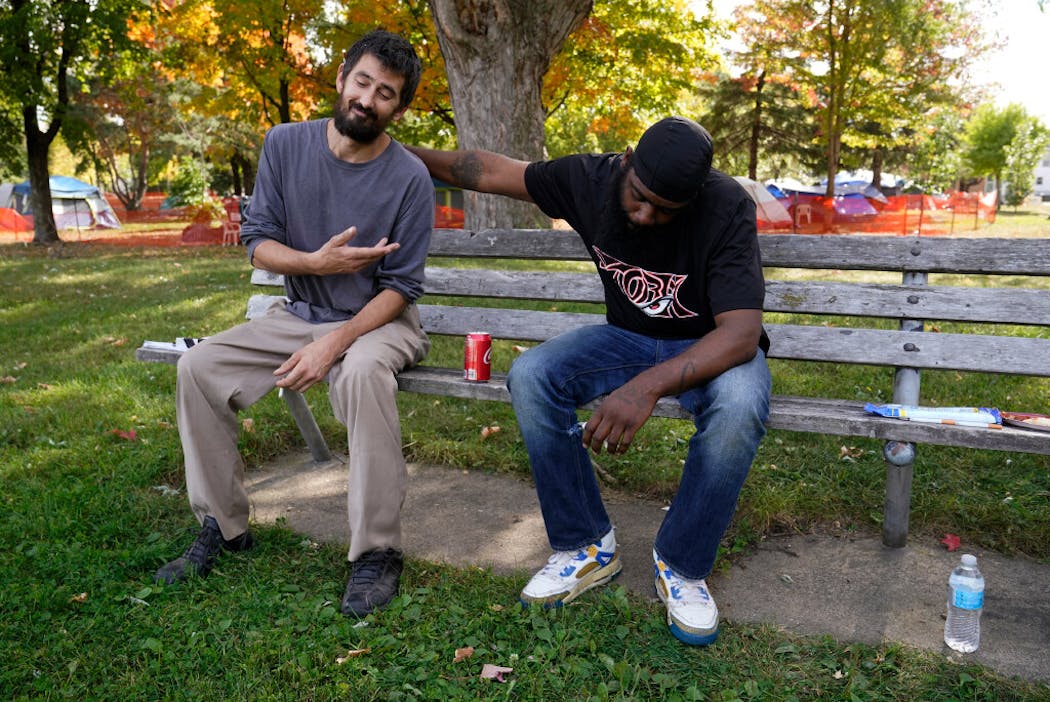For months, the encampment at Logan Park in northeast Minneapolis has enabled a small group of homeless people to find food, clothing and stability, a respite from the insecurities of life on the street.
Within days, their permit will expire and the Logan tent community, like 14 others still in the city's parks, will have to disband. The Minneapolis Park Board is looking to clear remaining encampments before freezing weather sets in.
Each encampment has been responsible for finding the next destination for its residents. Some are going to hotel rooms. Others are securing space in shelters or newly built tiny homes. Still others are relocating to the Midtown Greenway, setting up their tents underneath bridges or next to the bike trail.
The Logan Park encampment has a plan. When they disband next week, campers will stay at a hotel for a couple of weeks before returning to the neighborhood and moving to Strong Tower Parish, a church overlooking the park that is working to open as a 24-hour shelter this November.
Volunteers at the camp and with the church are moving fast to make sure everything is ready by the time they have to leave. They are still booking hotel rooms and waiting to hear back about necessary funding, but are confident they will be able to provide them a place to stay this winter.
For Brandon Harrison, who stayed at Logan for 2 ½ months, the encampment was a blessing.
After staying with his mother in Eden Prairie at the beginning of the year, Harrison and his girlfriend moved to Minneapolis in search of treatment for heroin addiction. They stumbled on the Logan Park encampment, one of the many that cropped up after camps at Powderhorn Park grew out of control.
"I eat better now than I had eaten with a pocket full of cash," said Harrison, who turned 35 this week. "The volunteers do more than just volunteer their goods and their commodities. They donate their time."
He walks to a nearby methadone clinic early every morning and goes to counseling once a week. He has made significant progress, going from using heroin multiple times a day for six years to using it two or three times this summer.
He and his girlfriend will likely join the rest of the campers at the hotel and then at the church shelter. They have talked about then moving into a sober-living house.
"We're finally able to achieve the sense of balance and reward for the basic simple things that a normal person does in life," he said.
This will be the second winter that Strong Tower Parish has opened its doors, said LaTonya Whitley, a minister at the parish and incoming director of its nonprofit arm. The church held 70 people last season, nearly all who then moved into apartments, transitional housing or hotels, she said.
This year, they're looking to house 50 people and have the space open 24 hours a day. The church is seeking $580,000 in CARES Act funding from the state and other sources to run the shelter through May. They would make several changes to the building, such as adding lockers and showers, as well as plexiglass and ventilation improvements to prevent coronavirus outbreaks.
"We need the money first, and everybody knows that," Whitley said. "Once we have the money, we will move."
Not everyone is fond of the shelter system. Sadie Laynn, who lives at Logan, said she feels unsafe inside them, having been harassed and robbed in the past. The Logan encampment was the one place where she felt she could leave her belongings unattended.
"I call this luxury homelessness. I've never had it like this before," Laynn, 38, said. "And the thing about these places is they just shut down anyway."
This will be her third winter without a home. She said she will apply to housing programs and see if she can find her own place.
"If not, I think I'm going to start walking south," she said, laughing. "I think I'd rather spend a winter on a sand bank than a snowbank."
The Logan Park campers will move to the hotel, which is being paid for by nonprofit ZACAH, on Oct. 13. Junail Anderson, who managed the encampment, was already contemplating bringing down some of the tents holding food, clothing and other goods.
Brian Wallace, 50, moved to Logan the same time Anderson set up the camp. He would likely go over to Strong Tower, where Anderson would help run the shelter.
"Where she go, I go," he said, holding a winter jacket and a pair of shoes he had just picked up. He is in the process of finding a job as an overnight custodian at government buildings downtown.
Anderson has big dreams for the future: to buy buildings exclusively for the homeless, where rent would be 30% of their income. That would lead to getting people off the ground and fewer people dying from the cold.
For now, she recognizes the shelter, like the other solutions people have devised this winter, are temporary.
"We're never going to end homelessness, but we do want to decrease homelessness," she said. "I don't want more deaths of homeless people."

'Safe recovery sites' would offer syringes, naloxone and more to people using drugs. The plan could be in peril.
New Minnesota GOP leaders seek peace with party's anti-establishment wing

Who is Republican Lisa Demuth, Minnesota's first House speaker of color?



